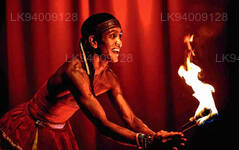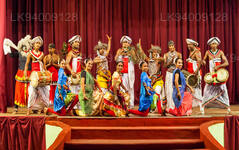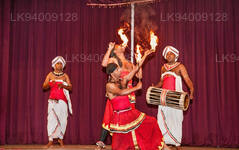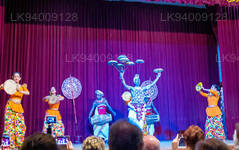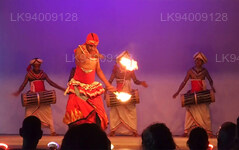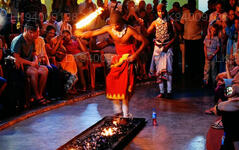
මහනුවර නගරය
මධ්යම ශ්රී ලංකාවේ දර්ශනීය නගරයක් වන මහනුවර, එහි පොහොසත් සංස්කෘතික උරුමයන්, සජීවී උත්සව සහ දර්ශනීය සුන්දරත්වය සඳහා ප්රසිද්ධය. සශ්රීක කඳු මුදුන් මැද පිහිටා ඇති එය, යුනෙස්කෝ ලෝක උරුම අඩවියක් වන දන්ත ධාතු මාලිගාවේ නිවහන වන අතර, ඉතිහාසයේ සහ ස්වභාවික තේජසෙහි ආකර්ශනීය මිශ්රණයක් ඉදිරිපත් කරයි.
Kandy Cultural Show
The Kandy Lake Club Cultural Dance Show is a stimulating Sri Lankan Arts, Dance & Cultural Heritage Show that is a must see for any visitor who visits the historic city of Kandy. The Kandy Lake Club Dance started in 1982 with the view of having a cultural dance performance bringing together all Sri Lankan dance types to one platform. It is the first Cultural Dance Show of its kind to be established in Sri Lanka. It has since become a tourist attraction for many people visiting the country and keen on a glimpse of its rich cultural heritage. Hence it has been performing continuously for the last 35 years. Dance techniques unique to areas of the island are usually passed on from generation to generation. These Dances are performed at local ceremonies and rituals using drums and costumes that are unique to each area. Among the attractions are the Dances depicting the majestic walk of the elephant, colourful performance of the peacock and the mystical movements of the cobra. There are also dances with traditional masks, traditional drums and flames. The show ends with the unbelievable feat of walking on red-hot charcoal, which is a traditional form of worship of local gods. Right throughout the show you can enjoy the sounds of drums and other traditional musical instruments of Sri Lanka.  A hand out in different languages gives our customers a description of every item with all interesting facts and features of the dance show.
The Kandy Lake Club Cultural Dance Show is a stimulating Sri Lankan Arts, Dance & Cultural Heritage Show that is a must see for any visitor who visits the historic city of Kandy. The Kandy Lake Club Dance started in 1982 with the view of having a cultural dance performance bringing together all Sri Lankan dance types to one platform. It is the first Cultural Dance Show of its kind to be established in Sri Lanka. It has since become a tourist attraction for many people visiting the country and keen on a glimpse of its rich cultural heritage. Hence it has been performing continuously for the last 35 years.
- Magul Bera: The blowing of the Conch Shell is the traditional invocation at the commencement of any function and the drums are an integral part of the ritual. It is an ancient Sinhala custom to present ritual music when seeking the blessings of the Guardian of the land.
- Puja Natuma: The female dancers carrying oil lamps are making an offering of their dancing skills to the Guardian Deities.
- Devol Natuma: A dance sequence performed for general immunity from evil influences as well as for healing specific ailments. It is a part of a ceremony connected with folk believes. The vigorous movements of the dancers are derived from the dance forms of the Southern parts of Sri Lanka.
- Mayura Natuma:The female dancers depict the graceful movements of the peacock which according to mythology is the bird that transports Skanda, the War-God of Ceylon, worshipped by Buddhists and Hindus alike.
- Pantheru Natuma: The name of the dance is derived from the musical instrument used, the pantheru, which is close akin to the tambourine. Rhythm is also provided by the accompanying drums. The dance itself shows Sinhala warriors on their way to battle.
- Raksha Natuma: A South Sri Lanka mask dance with the raksha masks symbolising the fight between a cobra and a bird. This dance is used to exorcise demons from the possessed and is still believed to be effective psychiatric treatment in Sri Lanka.
- Lee Keli Natuma: A dance popular in the all parts of the country, particularly during festivals in which both male and female dancers participate. Each dancer has two sticks and the sound of the sticks striking each other together with those of the accompanying drums provide the rhythm for the dancers.
- Raban Natuma: A traditional folk dance which uses the Rabana, an instrument similar to the drum. The popular Ath Rabana (hand Rabana) is almost one foot in diameter and is both played and wielded in a variety of forms by the male and female dancers. Raban playing is accompanied by singing too.
- Gini Sisila: A south Ceylon fire dance showing the power of charms over fire and the twenty seven devils that can trouble mankind. The absolute faith of the fire dancers protects them from the flames. This dance also includes fire-eating.
- Ves Natuma: This dance is the one of the most important forms of Kandyan dance. Ves is the traditional attire of the Kandyan dancer. Sixty four ornaments complete the dress and traditionally their sheen symbolizes the rays of the sun. It takes years of rigorous training before a dancer can achieve the status of a fully-fledged ves dancer.
- Kulu Natuma: A traditional folk dance performed by village damsels to celebrate a rich harvest. The dance portrays sequences from reaping to winnowing of the grain. This is a buoyant dance providing ample opportunities for displaying feminine grace. It is performed to the accompaniment of light drum beats and the haunting strains of the flute.
- Fire walking: The origin of fire walking can be traced back to the epic story of Rama and Sita. Ravana, the King of Ceylon, had abducted the princess of India, Sita. When Rama her husband (an Indian King) regained her, she proved her chastity during her enforced stay with Ravana, by walking on fire, barefoot and unhurt. The devotees who perform fire-walking seek the divine blessings of Lord Kataragama and Goddess Pattini before they do so.
During the show, you will see several dances which depict the graceful movements of birds and animals, which trace their origins back to the ancient ritual known as the Kohomba Kapkariya, as well as energetic acrobatic performances where the men perform a series of leaping pirouettes and stunts such as plate-spinning and the dramatic ‘fire walk’ which ends the show.
මහනුවර දිස්ත්රික්කය ගැන
මහනුවර දිස්ත්රික්කය ශ්රී ලංකාවේ මධ්යම පළාතේ පිහිටා ඇත. ශ්රී ලංකාවේ ලෝක උරුම ස්ථාන හතෙන් එකක් වන මහනුවර, 16 වන සියවසේ උඩරට රජවරුන්ගේ නිවහන වූ අතර රටේ සියලුම සංගීතය, කලා, ශිල්ප සහ සංස්කෘතිය සඳහා උල්පතක් විය. කොළඹ සිට කිලෝමීටර් 129 ක් පමණ දුරින් පිහිටි මහනුවර කඳුකර භූමි ප්රදේශයක් අතර පිහිටා ඇති අතර සියලු දෙනාගේම ඇස් නගර මධ්යයට ඇදී යයි, එහිදී මහනුවර වැව ආකර්ශනීය ලක්ෂණයක් සාදයි. මහනුවර ශ්රී ලංකාවට විශාල ආගමික වැදගත්කමක් දරන්නේ, මෙම ආකර්ශනීය නගරයේ දළදා මාලිගාව හෝ "දන්ත ධාතුව" පිහිටා ඇති අතර, එහි බුදුරජාණන් වහන්සේගේ පූජනීය දන්ත ධාතුව හොඳින් ආරක්ෂා කර ඇත. රාජකීය උද්භිද උද්යානය, පේරාදෙණිය, පේරාදෙණිය නගර මධ්යයේ සිට කිලෝමීටර් 5 ක් පමණ බටහිරින් පිහිටා ඇති අතර වසරකට මිලියන 1.2 ක ජනතාවක් එය නරඹති. එය දිවයිනේ විශාලතම උද්භිද උද්යානයයි. උඩවත්ත කැලේ (උඩවත්ත වනාන්තරය) යනු නගර මධ්යයේ, දළදා මාලිගාවට උතුරින් පිහිටි ආරක්ෂිත අභයභූමියකි. මහනුවර සිංහල බහුතරයක් වෙසෙන නගරයකි; මුවර්ස් සහ දෙමළ වැනි අනෙකුත් ජනවාර්ගික කණ්ඩායම්වලට අයත් සැලකිය යුතු ප්රජාවන් එහි සිටිති. ශ්රී ලංකා ආර්ථිකයේ කේන්ද්රස්ථානය වන කොළඹට පමණක් මහනුවර දෙවැනි වේ. බොහෝ ප්රධාන සමුපකාර ව්යාපාරවල මහනුවර විශාල ශාඛා නිලධාරීන් සිටින අතර රෙදිපිළි, ගෘහ භාණ්ඩ, තොරතුරු තාක්ෂණය සහ ස්වර්ණාභරණ ඇතුළු බොහෝ කර්මාන්ත මෙහි දක්නට ලැබේ. බොහෝ කෘෂිකාර්මික පර්යේෂණ මධ්යස්ථාන නගරයේ පිහිටා ඇත. රටේ සියලුම සංගීතය, කලා, ශිල්ප සහ සංස්කෘතිය සඳහා උල්පතකි. කොළඹ සිට කිලෝමීටර් 129 ක් පමණ දුරින් පිහිටි මහනුවර කඳුකර භූමි ප්රදේශයක් අතර පිහිටා ඇති අතර සියලු දෙනාගේ ඇස් නගර මධ්යයට යොමු වේ, එහිදී මහනුවර වැව ආකර්ශනීය ලක්ෂණයක් සාදයි. ශ්රී ලංකාවට මහනුවර විශාල ආගමික වැදගත්කමක් රඳවා තබා ගන්නේ මෙම ආකර්ශනීය නගරයේ දළදා මාලිගාව හෝ දන්ත දේවාලය පිහිටා ඇති අතර එහි බුදුරජාණන් වහන්සේගේ පූජනීය දන්ත ධාතුව හොඳින් ආරක්ෂා කර ඇත.
මධ්යම පළාත ගැන
ශ්රී ලංකාවේ මධ්යම පළාත ප්රධාන වශයෙන් කඳුකර භූමි ප්රදේශයකින් සමන්විත වේ. පළාතේ භූමි ප්රමාණය කිලෝමීටර 5,674 ක් වන අතර ජනගහනය 2,421,148 කි. මහනුවර, ගම්පොල (24,730), නුවරඑළිය සහ බණ්ඩාරවෙල සමහර ප්රධාන නගර වේ. ජනගහනය සිංහල, දෙමළ සහ මුවර්ස් මිශ්රණයකි. කඳුකර අගනුවර වන මහනුවර සහ නුවරඑළිය නගරය යන දෙකම මධ්යම පළාත තුළ මෙන්ම ශ්රී පාදය තුළ පිහිටා ඇත. පළාතේ කෝපි වගාවන් විනාශකාරී රෝගයකින් විනාශ වීමෙන් පසු 1860 ගණන්වල බ්රිතාන්යයන් විසින් රෝපණය කරන ලද ප්රසිද්ධ ලංකා තේ වලින් වැඩි ප්රමාණයක් පළාත විසින් නිෂ්පාදනය කරනු ලැබේ. මධ්යම පළාත බොහෝ සංචාරකයින් ආකර්ෂණය කර ගන්නා අතර, මහනුවර, ගම්පොල, හැටන් සහ නුවරඑළිය වැනි කඳුකර නගර ඇත. පන්සල් දළදා මාලිගාව යනු සෙන්ට්රල් පළාතේ ප්රධාන පූජනීය ස්ථානයයි. දේශගුණය සිසිල් වන අතර මීටර් 1500 ක් පමණ උස බොහෝ ප්රදේශ බොහෝ විට සීතල රාත්රීන් ඇත. බටහිර බෑවුම් ඉතා තෙත් වන අතර සමහර ස්ථානවල වසරකට මි.මී. 7000 කට ආසන්න වර්ෂාපතනයක් ලැබේ. නැගෙනහිර බෑවුම් මධ්යම වියළි කලාපයේ කොටස් වන අතර එයට වැසි ලැබෙන්නේ ඊසානදිග මෝසමෙන් පමණක් වන බැවිනි. මහනුවර උෂ්ණත්වය සෙල්සියස් අංශක 24 සිට මුහුදු මට්ටමේ සිට මීටර් 1,889 ක් ඉහළින් පිහිටි නුවරඑළියේ අංශක 16 දක්වා පරාසයක පවතී. ශ්රී ලංකාවේ උසම කඳු මධ්යම පළාතේ පිහිටා ඇත. භූමි ප්රදේශය බොහෝ දුරට කඳුකර වන අතර ගැඹුරු නිම්න එයට කපා ඇත. ප්රධාන කඳු කලාප දෙක වන්නේ මධ්යම කඳු පන්තිය සහ මහනුවර නැගෙනහිරින් පිහිටි නකල්ස් පරාසයයි.

